Documents: Go to download!
- User Manual - (English)
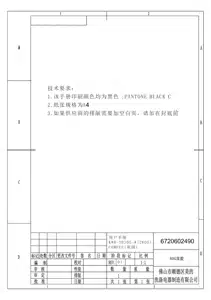
- GETTING TO KNOW YOUR APPLIANCE
- USING YOUR DISHWASHER
- PROGRAMMING THE DISHWASHER
- MAINTENANCE AND CLEANING
- TROUBLESHOOTING TIPS
Table of contents
User Manual ComfeeKWH-TD305-W Mini Plus Dishwasher
GETTING TO KNOW YOUR APPLIANCE
IMPORTANT:
Before using this dishwasher for the first time and to get the best performance, read these instructions.
Dishwasher features

To Wash Feeding Bottles
Feeding bottle rack will help to hold your feeding bottles during washing. It can load 2 sets of feeding bottles at the same time.

Control panel

Buttons
- Power To turn on and off.
- Hygiene 72° Press the button to select Hygiene 72° program.
- Intensive Press the button to select Intensive program. For heavily soiled items include pots and pans with dried-on food.
- ECO Press the button to select ECO program. This is the standard program suitable for normally soiled loads, such as pots, plates, glasses and lightly soiled pans.
- Glass Press the button to select Glass program. For lightly soiled crockery and glass. Press 4 and 5 together for 3 seconds to start self-clean program to provides an effective cleaning of the dishwasher itself.
- 58min wash Press the button to select 58min wash program.
- Rapid Press the button to select Rapid wash program. A shorter wash for lightly soiled loads that do not need drying. Press 6 and 7 together for 3 seconds to switch on/off auto door opening function in all the programs.
- Delay - Press this button to reduce the delayed hours for washing. One press on this button reduce the delay of the start of washing by one hour.
- Delay + Press this button to set the delayed hours for washing. You can delay the start of washing up to 24 hours. One press on this button delays the start of washing by one hour. Press 8 and 9 together for 3 seconds to activate or inactivate child lock. Child lock allows you to lock the buttons except the Power button.
- Start/Pause To start the selected.washing program or pause it when the dishwasher is working.
- Screen
 Digital Display To show the remaining time and delay time, functions, error codes etc.
Digital Display To show the remaining time and delay time, functions, error codes etc. Salt If the "
Salt If the " " indicator is lit, it means the dishwasher is low on dishwasher salt and needs to be refilled.
" indicator is lit, it means the dishwasher is low on dishwasher salt and needs to be refilled. Water Faucet If the "
Water Faucet If the "  " indicator is lit, it means the water faucet closed.
" indicator is lit, it means the water faucet closed. Auto Open If the "
Auto Open If the " " indicator is lit, it means the door will open automatically for better drying.
" indicator is lit, it means the door will open automatically for better drying. Child lock If the "
Child lock If the " " indicator is lit, it means the child lock is on.
" indicator is lit, it means the child lock is on. Self Clean If the "
Self Clean If the " " indicator is lit, it means the self-clean program is running.
" indicator is lit, it means the self-clean program is running. - Light ring The color of the ring will turn red if the water temperature is over 59 °C.
USING YOUR DISHWASHER
NOTE If your model have no water softener, you may skip this section.
Loading the salt into the softener
Always use salt intended for use with dishwasher. The salt container is located beneath the basket and should be filled as follows:
WANING
- Only use salt specifically designed for dishwashers use!
Every other type of salt not specifically designed for dishwasher use, especially table salt, will damage the water softener. In case of damages caused by the use of unsuitable salt the manufacturer does not give any warranty nor is liable for any damages caused. - Only fill with salt before running a cycle.
This will prevent any grains of salt or salty water, which may have been spilled, remaining on the bottom of the machine for any period of time, which may cause corrosion.

A. Remove the basket and then unscrew and remove the cap from the salt container.
B. Before first wash, add 1lt. of water in the salt container of your machine.
C. Place the end of the funnel (if supplied) into the hole and introduce about, 0.13kg of salt. It is normal for a small amount of water to come out of the salt container.
D. After filling the container, screw the cap tightly back clockwise.
E. Usually, the salt warning light will be cease to be illuminated within 2-6 days after the salt container has been filled with salt.
F. Immediately after filling the salt into the salt container, a washing programme should be started (Suggest choose rapid program). Otherwise filter system, pump or other important parts of the machine may be damaged by salty water. It is out of warranty.
NOTE
- The salt container must only be refilled when the salt warning light in the control panel comes on. Depending on how fully the salt dissolves, the salt warning light may still be on even though the salt container is filled.
If there is no salt warning light in the control panel (For some Models), you can judge when to load the salt into the softener by the cycles that the dishwasher had run. - If there are spills of the salt, a soak or a rapid program should be run to remove the excess salt.
Adjusting Salt Consumption
Please follow the steps below for adjustment in salt consumption.
Step 1: Enter the status of salt adjustment
Close the door, within 60 seconds after power on, press Rapid button and hold for 5 seconds, the machine will enter setting mode.
Step 2: select a certain level of salt consumption
Press the Rapid button to select the proper set according to your local environment, the sets will change in the following sequence: H1->H2->H3->H4->H5->H6.
Step 3: Exit the status of salt adjustment
Without any operation in five seconds, the machine will exit from set mode, the machine is into standby status.
There are 6 levels of salt consumption in all. It is recommended to select the level according to below table:
WATER HARDNESS | Setting on the water softener | Digital display stalls | Salt consumption(gram/cycle) | |
"dH 1 | Mmol/l 2 | |||
0 - 5 | 0 - 0.94 | 1 | H1 | 0 |
6 - 11 | 1.0 - 2.0 | 2 | H2 | 4 |
12 - 17 | 2.1 - 3.0 | 3 (3 ) | H3 | 8 |
18 - 22 | 3.1 - 4.0 | 4 | H4 | 13 |
23 - 34 | 4.1 - 6.0 | 5 | H5 | 20 |
35 - 55 | 6.1 - 9.8 | 6 | H6 | 40 |
- German degree of measurement for the water hardness
- millimol, internationel unit for water hardness
- factory setting
Contact your local water board for information on the hardness of your water supply.
Loading the dishwasher baskets
Recommendation
- Consider buying utensils which are identified as dishwasher-proof.
- Use a mild detergent that is described as 'kind to dishes'. If necessary, seek further information from detergent manufacturers.
- For particular items, select a program with as low temperature as possible.
- To prevent damage, do not take glass and cutlery out of the dishwasher immediately after the program has ended.
Suitability of use in the dishwasher
Not suitable for use:
- Cutlery with wooden, horn, china or mother-of-pearl handles
- Plastic items that are not heat resistant
- Older cutlery with glued parts that are not temperature resistant
- Bonded cutlery items or dishes
- Pewter or copper items
- Crystal glass
- Steel items subject to rusting
- Wooden items
- Items made from synthetic fibres
Limited suitability:
- Some glasses can become dull after a large number of washes.
- Silver and aluminium have a tendency to discolour during washing.
- Glazed patterns may fade if washed frequently.
Attention before or after loading the dishwasher baskets
(For the best performance of the dishwasher, follow these loading guidelines. Features and appearance of baskets and cutlery baskets may vary from your model.)
Scrape off any large food paritcles. Soften remnants of burnt food in pans. It is not necessary to rinse the dishes under running water. Place objects in the dishwasher in following way:
- Items such as cups, glasses, pots/pans, etc. are face downwards.
- Curved items, or those with recesses, should be loaded at aslant so that water can run off.
- All utensils are stacked securely and can not tip over.
- All utensils are placed in the way that the spray arms can rotated freely during washing.
NOTE Very small items should not be washed in the dishwasher as they could easily fall out of the basket.
- Load hollow items such as cups, glasses, pans etc. with the opening facing downwards so that water cannot collect in the container or a deep base.
- Dishes and items of cutlery must not lie inside one another, or cover each other.
- To avoid damage to glasses, they must not be touched.
- Long bladed knives stored in an upright position are a potential hazard!
- Long and/or sharp items of cutlery such as carving knives must be positioned horizontally in the basket.
- Please do not overload your dishwasher. This is important for good results and for reasonable energy consumption.
Use of the dishware support
Small-size dishware will drop through the basket and block the rotation of spray arm.
Flip the dishware support inward to support the small-size dishware.
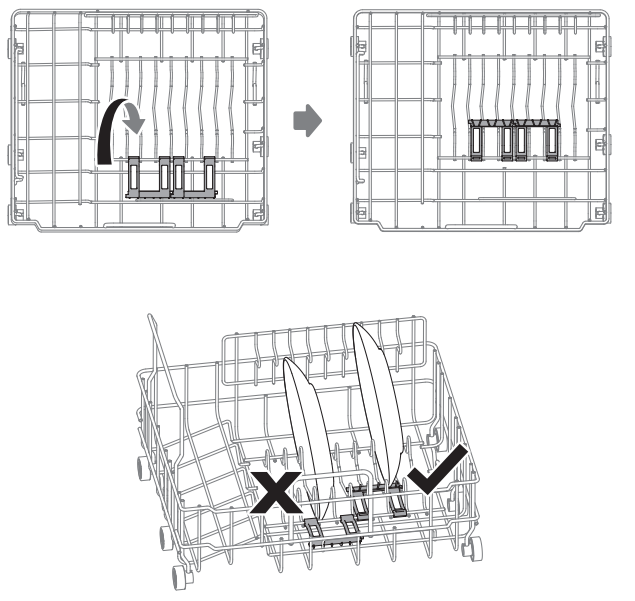
Loading the basket according to EN50242
Loading basket
Position the dishes and cookware so that they will not get moved by the spray of water.

Number- Item
- Oval Plate
- Dinner Plate
- Soup Plate
- Dessert Dish
- Saucer
- Small Serving Bowl
- Medium Serving Bowl
- Glass
- Cup
Loading the cutlery basket
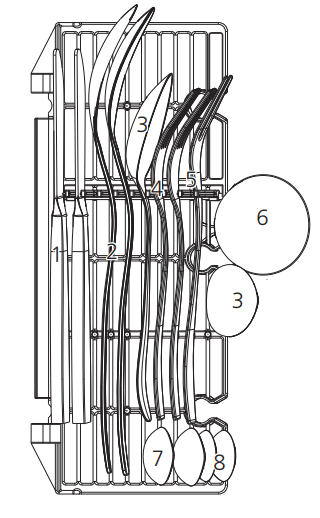
Number- Item
- Knife
- Serving spoon
- Soup spoon
- Fork
- Serving fork
- Gravy ladle
- Dessert spoon
- Tea spoon
For personal safety and a top quality clean, make sure place the silverware in the basket as follows:
- They do not nest together.
- Place silverware with handles-down.
- But place knives and other potentially dangerous utensils handles-up.
Loading the basket according to EN60436
Loading basket
Position the dishes and cookware so that they will not get moved by the spray of water.
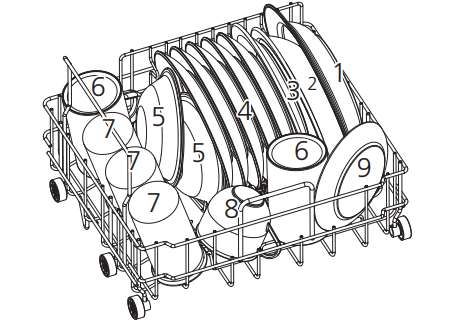
Number-Item
- Soup plate
- Melamine bowl
- Melamine dessert plate
- Dessert plate
- Dessert bowl
- Mug
- Glass
- Cup
- Saucer
Loading the cutlery basket

Number-Item
- Knife
- Soup spoon
- Teas poon
- Dessert spoon
- Fork
- Serving fork
- Gravy ladle
For personal safety and a top quality clean, make sure place the silverware in the basket as follows:
- They do not nest together.
- Place silverware with handles-down.
- But place knives and other potentially dangerous utensils handles-up.
Adding the detergent
WANING
- Only use detergent specifically for dishwashers.
Never use any other detergents. This will damage the appliance.
 Dishwasher detergent is corrosive! Keep dishwasher detergent out of the reach of children.
Dishwasher detergent is corrosive! Keep dishwasher detergent out of the reach of children.
Concentrated Detergent
Based on their chemical composition, detergents can be split in two basic types:
- Conventional, alkaline detergents with caustic components.
- Low alkaline concentrated detergents with natural enzymes.
The use of Normal washing program in combination with concentrated detergent reduces pollution and is good for your dishes.
Detergent Tablets
Detergent tablets of different brands dissolve at different speeds. For this reason some detergent tablets cannot dissolve and develop their full cleaning power during short programs. Therefore please use long programs when using detergent tablets, to ensure the complete removal of detergent residuals.
Detergent
The detergent must be refilled before the start of each wash cycle following the instructions provided in the Wash Cycle Table. Your dishwasher uses less detergent then conventional dishwasher. Generally, only one tablespoon of detergent is needed for a normal wash load. More heavily soiled items need more detergent. Always add the detergent just before starting the dishwasher, otherwise it could get damp and will not dissolve properly.
Adding detergent
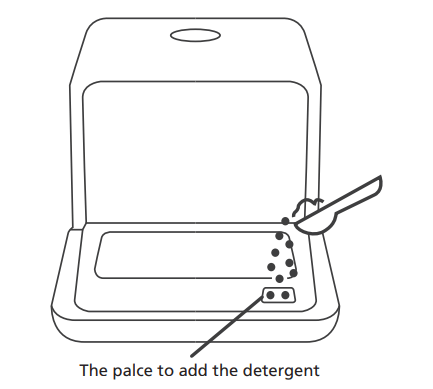
PROGRAMMING THE DISHWASHER
Wash cycle table according to EN50242
The table below shows the best programmes for the levels of food residue on them and how much detergent is needed. It also show various information about the programmes.
Program | Cycle Selection Information | Description Of Cycle | Detergent | Time (min) | Energy (Kwh) | Water (L) |
(*EN50242) | The standard programme, suitable to clean normally soiled tableware and is the most efficient programme in terms of its combined energy and water consumption for that type of tableware. | Wash (55 °C) Rinse Rinse (70 °C) Drying | 6 g | 155 | 0.433 | 6.0 |
Hygiene 72° | Use to sanitize your dishes and glassware. Maintains the water temperature at around 72 °C. | Wash(70 °C) Rinse Rinse(72 °C) Drying | 6 g | 115 | 0. 590 | 6.0 |
Intensive | For heavily soiled items include pots and pans with dried-on food. | Wash (62 °C) Rinse Rinse (70 °C) Drying | 6 g | 160 | 0.580 | 6.0 |
Glass | For lightly soiled loads, such as glasses, crystal and fine china | Wash(50 °C) Rinse Rinse(65 °C) Drying | 6 g | 85 | 0.380 | 6.0 |
 58min Wash | For normally soiled loads that need quick wash. | Wash(55 °C) Rinse Rinse(65 °C) Drying | 6 g | 58 | 0.390 | 6.0 |
Rapid | A shorter wash for lightly soiled loads that do not need drying. | Wash (50 °C) Rinse Rinse (60 °C) | 6 g | 29 | 0.290 | 6.0 |
 Self-cleaning | To provides an effective cleaning of the dishwasher itself | Wash (60 °C) Rinse Rinse (70 °C) | 6 g | 65 | 0.430 | 6.0 |
NOTE: ECO (*en50242)This program is the test cycle. The information for comparability test in accordance with EN50242.
Wash cycle table according to EN60436
The table below shows the best programmes for the levels of food residue on them and how much detergent is needed. It also show various information about the programmes.
Program | Cycle Selection Information | Description Of Cycle | Detergent | Time (min) | Energy (Kwh) | Water (L) |
(*EN50242) | The standard programme, suitable to clean normally soiled tableware and is the most efficient programme in terms of its combined energy and water consumption for that type of tableware. | Wash (55 °C) Rinse Rinse (70 °C) Drying | 11 g | 155 | 0.446 | 6.0 |
Hygiene 72° | Use to sanitize your dishes and glassware. Maintains the water temperature at around 72 °C. | Wash(70 °C) Rinse Rinse(72 °C) Drying | 11 g | 115 | 0. 590 | 6.0 |
Intensive | For heavily soiled items include pots and pans with dried-on food. | Wash (62 °C) Rinse Rinse (70 °C) Drying | 11 g | 160 | 0.580 | 6.0 |
Glass | For lightly soiled loads, such as glasses, crystal and fine china | Wash(50 °C) Rinse Rinse(65 °C) Drying | 11 g | 85 | 0.380 | 6.0 |
 58min Wash 58min Wash | For normally soiled loads that need quick wash. | Wash(55 °C) Rinse Rinse(65 °C) Drying | 11 g | 58 | 0.390 | 6.0 |
Rapid | A shorter wash for lightly soiled loads that do not need drying. | Wash (50 °C) Rinse Rinse (60 °C) | 11 g | 29 | 0.290 | 6.0 |
 Self-cleaning | To provides an effective cleaning of the dishwasher itself | Wash (60 °C) Rinse Rinse (70 °C) | 11 g | 65 | 0.430 | 6.0 |
NOTE: ECO (*EN60436)This program is the test cycle. The information for comparability test in accordance with EN50242.
Turning on the appliance
Starting a wash cycle...
Draw out the basket(see the section entitled "Loading the Dishwasher").
Pour in the detergent (see the section"Fill the detergent").
Insert the plug into the socket. The power supply is 220-240VAC 50Hz, the specification of the socket is 10A 250V AC.
Press the power button to turn on the appliance,
Connect the inlet hose to the tap, make sure that the water supply is turned on to full pressure, or add water the the tank manually. select a suitable program according to the "Wash cycle table";
If a program is selected, the corresponding light will be lit. Then press the Start/Pause button, the dishwasher begins to start.
Change the programme
Premise: You can modify the washing program, if the dishwasher just worked for a short time. Otherwise, the detergent may have already been released, and the appliance may have already drained the wash water in this case, the cycle must be restarted.
Press Start/Pause Button to pause the machine when the door is closed,
Press Program Button for more than 3 seconds the machine will be in stand-by state, then you can change the program to the desired cycle setting (see the section entitled "Starting a wash program" ).
The Display window shows the state of the dishwasher:
a) Display window shows "-:--" ----------------------------------> stand by;
b) Display window shows "H:MM" and not blinking -------------> pause;
c) Display window shows "H:MM" and blinking ------------------------> run;
d) Display window shows "END" ------------------------> end.
NOTE
If you open the door during washing, the machine will pause. When you and press the Start/Pause Button, the machine will keep on working after 10 seconds.
If your model has broken remember function, the machine will go on to finish the selected program after the power cut.
Forget to add a dish?
A forgotten dish can be added any time before the detergent dispenser opens. If this is the case, follow the instructions below:
- Press the Start/Pause button.
- Open the door.
- Add forgotten dishes.
- Close the door.
- Press the Start/Pause button, the dishwasher will run .

At the end of the Wash Cycle
When the working cycle has finished, the buzzer of dishwasher will sound 8 seconds, then stop. Turn off the appliance using the ON/OFF button, shut off the water supply and open the door of the dishwasher. Wait a few minutes before unloading the dishwasher to avoid scald, the dishes and utensils are still hot and more susceptible to breakage. They will also dry better.
Switch Off the Dishwasher
- Switch off the dishwasher by pressing the ON/OFF button.
- Turn off the water tap.
Open the door carefully
Hot dishes are sensitive to knocks. The dishes should be allowed to cool down around 15 minutes before removing from the appliance.
Open the dishwasher's door, leave it open and wait a few minutes before removing the dishes. In this way they will be cooler and the drying will be improved.
Unloading the dishwasher
It is normal that the dishwasher is wet inside.
Forced drainage operation
In standby mode, you can press and hold “Hygiene” button + “Rapid” button for 3 seconds simultaneously to drain the water tank.
MAINTENANCE AND CLEANING
Filter system
The filter efficiently removes food particles from the wash water , allowing it to be recycled during the cycle.
For best performance and results, the filter assembly must be cleaned regularly For this reason, it is a good idea to move the larger food particles trapping in the filter after each wash cycle by rinsing the filter and cup under running water.
To remove the filter assembly, rotate the filter handle anticlockwise and then pull the handle in the upward direction.
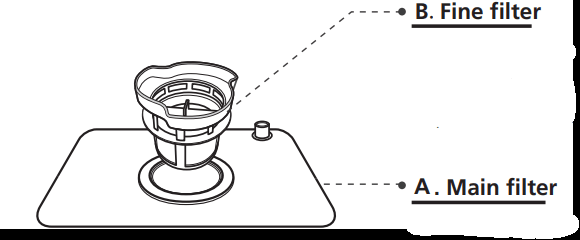
B.Fine filter
This filter holds soil and food residues in the sump area and prevents it from being deposited on the dishes during wash cycle
A . Main filter
Food and soil particles trapped in this filter are pulverized by a special jet on the lower spray arm and washed down to drain.
Step 1: Contrarotate the filter assembly, then lift it all up.

Step 2: Lift fine filter up from main filter.

NOTE If do it from step1 to step 2, the filter system will be removed; while if do it from Step 2 to Step 1, the filter system will be installed. The entire filter assembly should be cleaned once a week.
- Inspect the filters for blocking after every time the dishwasher has been used.
- By unscrewing the coarse filter, you can remove the filter system. Remove any food remnants and clean the filters under running water.
WANING When cleaning the filters, don't knock on them. Otherwise, the filters could be contorted and the performance of dishwasher could be decreased.
Caring for the Dishwasher
The control panel can be cleaned by using a lightly dampened cloth. After cleaning, make sure to dry it thoroughly. For the exterior use a good appliance polish wax. Never use sharp objects, scouring pads or harsh cleaners on any part of the dishwasher.
Cleaning The Door
To clean the edge around the door, you should use only a soft warm, damp cloth.
To avoid penetration of water into the door lock and electrical components, do not use a spray cleaner of any kind
Protect against freezing
please take frost protection measures on the dishwasher in winter. Each time after washing cycles, please operate as follows.
- Cut off electrical power to the dishwasher.
- Turn off the water supply and disconnect the water inlet pipe from the water valve.
- Drain water from the inlet pipe and water valve (Use a pan to catch the water).
- Reconnect the water inlet pipe to the water valve.
- Remove the filter at the bottom of the tub and use a sponge to soak up water in the sump.
Cleaning the spray arms
The spray arms can be easily removed for periodic cleaning of the nozzles to prevent possible clogging. Wash them under running water and carefully replace them in their seats, checking that their rotary movement is in no way impeded.
Grasp the middle of the spray arm, pull it upwards to remove it. Wash the arms under a jet of running water and replace it carefully to its seat. After reassembly, check that the spray arms rotate freely. Otherwise, check that they have been installed correctly.
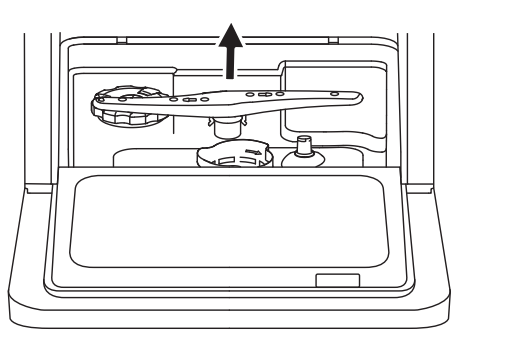
How to keep your dishwasher in shape
After every wash
After every wash, turn off the water supply to the appliance and leave the door slightly open so that moisture and odours are not trapped inside.
Remove the plug
Before cleaning or performing maintenance, always remove the plug from the socket.
No solvents or abrasive cleaning
To clean the exterior and rubber parts of the dishwasher, do not use solvents or abrasive cleaning products. Only use a cloth with warm soapy water.
To remove spots or stains from the surface of the interior, use a cloth dampened with water an a little vinegar, or a cleaning product made specifically for dishwashers.
When not in use for a longtime
It is recommend that you run a wash cycle with the dishwasher empty and then remove the plug from the socket, leave the door of the appliance open. This will help the door seals to last longer and prevent odours from forming within the appliance.
Moving the appliance
If the appliance must be moved, try to keep it in the vertical position. If absolutely necessary, it can be positioned on its back.
TROUBLESHOOTING TIPS
Before calling for service
Reviewing the charts on the following pages may save you from calling for service.
Problem | Possible Causes | What To Do |
| Dishwasher doesn't start | Fuse blown, or the circuit break tripped. | Replace fuse or reset circuit breaker. Remove any other appliances sharing the same circuit with the dishwasher. |
| Power supply is not turned on. | Make sure the dishwasher is turned on and the door is closed securely. Make sure the power cord is. properly plugged into the wall socket. | |
Error code:E1; Water pressure is low | Check that the water supply is connected properly andthe water is turned on. | |
| Door of dishwasher not properly closed. | Make sure to close the door properly and latch it. | |
| Water not pumped form dishwasher | Twisted or trapped drain hose. | Check the drain hose. |
| Filter clogged. | Check coarse the filter. | |
| Kitchen sink clogged. | Check the kitchen sink to make sure it is draining well.If the problem is the kitchen sink that is not draining, you may need a plumber rather than a serviceman for dishwashers. | |
| Suds in the tub | Wrong detergent. 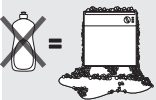 | Use only the dedicated dishwasher detergent to avoid suds. If suds exist in the washer. Open the door for 20-30 minutes to allow the foam to evaporate. If the foam still exists in the liner. Add 1.5L of water to the liner, close the dishwasher door and run a forced drain to drain it with the water. Repeat above operation until the foam is cleared. |
| Stained tub interior | Detergent with colourant may have been used. | Make sure that the detergent has no colourant. |
| White film on inside surface | Hard water minerals. | To clean the interior, use a damp sponge with dishwasher detergent and wear rubber gloves. Never use any other cleaner than dishwasher detergent otherwise, it may cause foaming or suds. |
| There are rust stains on cutlery | The affected items resistant. | Avoid washing items that are not corrosion resistant in the dishwasher . |
| A programme was not run after dishwasher salt was added. Traces of salt have gotten into the wash cycle. | Always run a wash programme without any crockery after adding salt. | |
| The lid of the softer is loose. | Check the softener lid is secure. | |
| Knocking noise in the dishwasher | A spray arm is knocking against an item in a basket | Interrupt the programme and rearrange the items which are obstructing the spray arm. |
| Rattling noise in the dishwasher | Items of crockery are loose in the dishwasher. | Interrupt the programme and rearrange the items of crockery. |
| Knocking noise in the water pipes | This may be caused by on-site installation or the cross-section of the piping. | This has no influence on the dishwasher function. If in doubt, contact a qualified plumber. |
| The dishes are not clean | The dishes were not loaded correctly. | See notes in "Loading & unloading your dishwasher". |
| The programme was not powerful enough. | Select a more intensive programme. | |
| Not enough detergent was dispensed. | Use more detergent, or change your detergent. | |
| Items are blocking the movement of the spray arms. | Rearrange the items so that the spray can rotate freely . | |
| The filter combination is not clean or is not correctly fitted in the base of washcabinet. This may cause the spray arm jets to get blocked. | Clean and/or fit the filter correctly Clean the spray arm jets. | |
| Cloudiness on glassware. | Combination of soft water and too much detergent. | Use less detergent if you have soft water and select a shorter cycle to wash the glassware and to get them clean. |
| White spots appear on dishes and glasses. | Hard water area can cause limescale deposits. | Add more detergent. |
| Black or grey marks on dishes | Aluminium utensils have rubbed against dishes | Use a mild abrasive cleaner to eliminate those marks. |
The dishesare not drying
| Improper loading | Load the dishwasher as suggested in the directions. |
| Dishes are removed too soon | Do not empty your dishwasher immediately after washing. Open the door slightly so that the steam can come out. Take out the dishes until the inside temperature is safe to touch. Unload the lower basket first to prevent the dropping water from the upper basket. | |
| Wrong program has been selected. | With a short programme, the washing temperature is lower, decreasing cleaning performance. Choose a programme with a long washing time. | |
| Use of cutlery with a low-quality coating. | Water drainage is more difficult with these items. Cutlery or dishes of this type are not suitable for washing in the dishwasher. |
Error codes
When some malfunctions come on, the appliance will display error codes to warn you:
Codes | Meanings | Possible Causes |
E1 | Longer inlet time. | A flow meter, drain valve, or pump failure, it should be repaired by a qualified worker. |
E3 | Not reaching required temperature | Heating tube or thermistor anomaly, it should be repaired by a qualified worker. |
E4 | Overflow. | Some element of dishwasher leaks. |
Ed | Communication anomaly | It should be repaired by a qualified worker. |
WANING
- If overflow occurs, turn off the main water supply before calling a service.
- If there is water in the base pan because of an overfill or small leak, the water should be removed before restarting the dishwasher.
See other models: 20S CO-A101A CFO-CC2501 CM-M093ARD CM-M092AAT





